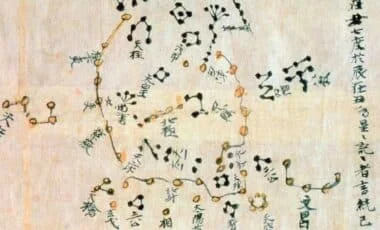
Ancient Chinese Star Catalog: A 2,300-Year-Old Astronomical Revelation?
A newly analyzed ancient Chinese manuscript, the Star Manual of Master Shi, is causing a stir in the astronomy world. Researchers claim it could be the oldest surviving star catalog, dating back to approximately 355 BC. This would predate the previously recognized Hipparchus catalog by centuries, potentially rewriting our understanding of astronomical history.
The Star Manual of Master Shi, attributed to astronomer Shi Shen from the Warring States period, has long puzzled historians due to inconsistencies in star positions. Now, astronomers from the Chinese National Astronomical Observatories (NAO) are using advanced computational methods to analyze the manuscript.

Dating the Stars with AI
The team, led by Boliang He and Yongheng Zhao, employed a sophisticated AI technique called the Generalized Hough Transform to analyze the star catalog. This method allowed them to account for Earth’s axial precession and identify potential updates made to the catalog over time. Their analysis suggests that about half of the star positions date back to 355 BC, while the other half were likely updated around 125 AD during the Eastern Han dynasty, potentially under the direction of the renowned astronomer Zhang Heng.
According to He, "Our findings align perfectly with these historical accounts, vividly demonstrating the continuity and completeness of ancient Chinese historical records… These discoveries left us deeply surprised."
A Celestial Court and Imperial Mandate
The catalog isn't just a list of stars; it's a reflection of ancient Chinese culture. The constellations depict an imperial court in the sky, full with an emperor’s chariot and even a star representing a toilet. These celestial images highlight how early astronomers organized the night sky into symbolic forms mirroring Earthly structures. This system reinforced the emperor’s mandate, allowing court astrologers to interpret cosmic events as guidance for maintaining harmony.
Controversy Among Scholars
While the potential significance of this discovery is widely recognized, some scholars remain skeptical. Historian Boshun Yang argues that the older star positions could be the result of measurements taken with a misaligned instrument. He suggests that the catalog's coordinate system aligns better with a first-century BC origin.
Daniel Patrick Morgan, historian at France’s Center for Research on East Asian Civilizations, emphasizes that such an early dating poses a challenge to conventional historical understanding.

Global Impact on Astronomical History
If confirmed, the Star Manual of Master Shi would not only be older but also unique in its detailed graphical layouts and coordinate systems, setting it apart from earlier Babylonian records. This shifts the narrative in astronomical studies and highlight the importance of acknowledging China’s foundational contribution to humanity discovering the universe.
The ongoing debate notwithstanding, the ancient Chinese star chart stands as a testament to China’s scientific achievements. This potentially transformative chart, if authenticated, predates its Greek and Babylonian relatives in both structure and style, and promotes cross-cultural exchange as researchers delve deeper into traditional Chinese star catalogs.
This groundbreaking claim is currently under review, but regardless of the final verdict, one thing is clear: the Star Manual of Master Shi is forcing us to reconsider the origins of astronomy and the contributions of ancient Chinese scholars. What are your thoughts on this fascinating discovery? Do you think it will ultimately rewrite the history books? Share your comments below!